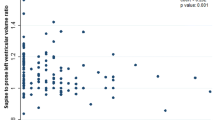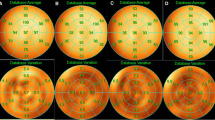Abstract
Background
Stress-only single-photon emission computed tomography myocardial perfusion imaging (SO SPECT MPI) is associated with similarly benign prognosis as stress-rest SPECT MPI. However, previous studies have used attenuation correction rather than prone imaging to increase the rate of SO studies.
Objectives
To assess the prognosis of SO SPECT MPI performed with prone imaging.
Methods
We performed a retrospective cohort analysis of all patients who underwent a Tc-99m gated SPECT MPI over a 58-month period.
Results
Two thousand four hundred and sixty five patients were followed up. Of them, 1114 (45.2%) patients had a SO supine test, 388 (15.7%) underwent a SO supine and prone test, and the remaining 963 (39.1%) patients underwent a full stress-rest SPECT MPI. There was a similar annual mortality rate between the SO supine/prone group (1.3%), the SO supine (1.5%), and the stress-rest (1.5%) group (P = 0.47). Patients in the stress-rest group were significantly more likely to suffer from myocardial infarction (MI) as compared to the other two groups with an annual rate of 0.7% as compared to 0.4% (P = 0.049).
Conclusions
Normal supine-prone SO SPECT MPI is associated with a similarly benign prognosis as stress-rest SPECT MPI. The adjunction of prone imaging to the stress supine significantly increases the rate of SO SPECT MPI





Similar content being viewed by others
Abbreviations
- SO:
-
Stress-only
- SPECT:
-
Single-photon emission computed tomography
- MPI:
-
Myocardial perfusion imaging
- CAD:
-
Coronary artery disease
- AC:
-
Attenuation correction
- CABG:
-
Coronary artery bypass graft
- PCI:
-
Percutaneous coronary intervention
- MI:
-
Myocardial infarction
- LV:
-
Left ventricular
References
Hendel RC, Berman DS, Di Carli MF, Heidenreich PA, Henkin RE, Pellikka PA, et al. ACCF/ASNC/ACR/AHA/ASE/SCCT/ SCMR/SNM 2009 appropriate use criteria for cardiac radionuclide imaging: A report of the American College of Cardiology Foun- dation Appropriate Use Criteria Task Force, the American Society of Nuclear Cardiology, the American College of Radiology, the American Heart Association, the American Society of Echocardiography, the Society of Cardiovascular Computed Tomography, the Society for Cardiovascular Magnetic Resonance, and the Society of Nuclear Medicine. J Am Coll Cardiol 2009;53:2201-29.
Henzlova MJ, Croft LB, Duvall WL. Stress-only imaging: Faster, cheaper, less radiation. So what’s the hold up? J Nucl Cardiol 2012;19:1092-3.
Henzlova MJ, Cerqueira MD, Mahmarian JJ, Yao SS. Stress protocols and tracers. J Nucl Cardiol 2006;13:e80-90.
Thompson RC, Cullom SJ. Issues regarding radiation dosage of cardiac nuclear and radiography procedures. J Nucl Cardiol 2006;13:19-23.
Bhavnani SP, Heller GV. Stress-only myocardial perfusion imaging…it is time for a change! J Nucl Cardiol 2011;18:836-9.
Mahmarian JJ. Stress only myocardial perfusion imaging: Is it time for a change? J Nucl Cardiol 2010;17:529-35.
Iskandrian AE. Stress-only myocardial perfusion imaging a new paradigm. J Am Coll Cardiol 2010;55:231-3.
Duvall WL, Guma KA, Kamen J, Croft LB, Parides M, George T, et al. Reduction in occupational and patient radiation exposure from myocardial perfusion imaging: Impact of stress-only imaging and high-efficiency SPECT camera technology. J Nucl Med 2013;54:1251-7.
Chang SM, Nabi F, Xu J, Raza U, Mahmarian JJ. Normal stress- only versus standard stress/rest myocardial perfusion imaging: Similar patient mortality with reduced radiation exposure. J Am Coll Cardiol 2010;55:221-30.
Gibson PB, Demus D, Noto R, Hudson W, Johnson LL. Low event rate for stress-only perfusion imaging in patients evaluated for chest pain. J Am Coll Cardiol 2002;39:999-1004.
Mathur S, Heller GV, Bateman TM, Ruffin R, Yekta A, Katten D, et al. Clinical value of stress-only Tc-99m SPECT imaging: Importance of attenuation correction. J Nucl Cardiol 2013;20:27-37.
Duvall WL, Wijetunga MN, Klein TM, Hingorani R, Bewley B, Khan SM, et al. Stress-only Tc-99m myocardial perfusion imaging in an Emergency Department Chest Pain Unit. J Emerg Med 2011;42:642-50.
Tragardh E, Valind S, Edenbrandt L. Adding attenuation corrected images in myocardial perfusion imaging reduces the need for a rest study. BMC Med Imaging 2013;13:14.
Duvall WL, Wijetunga MN, Klein TM, Razzouk L, Godbold J, Croft LB, et al. The prognosis of a normal stress-only Tc-99m myocardial perfusion imaging study. J Nucl Cardiol 2010;17:370-7.
Ueyama T, Takehana K, Maeba H, Iwasaka T. Prognostic value of normal stress-only technetium-99 m myocardial perfusion imaging protocol comparison with standard stress-rest protocol. Circ Jpn 2012;76:2386-91.
Slomka PJ, Berman DS, Germano G. New cardiac cameras: single-photon emission CT and PET. Semin Nucl Med 2014;44:232-51.
Nishina H, Slomka PJ, Abidov A, Yoda S, Akincioglu C, Kang X, et al. Combined supine and prone quantitative myocardial perfusion SPECT: method development and clinical validation in patients with no known coronary artery disease. J Nucl Med 2006;47:51-8.
Hayes SW, De Lorenzo A, Hachamovitch R, Dhar SC, Hsu P, Cohen I, et al. Prognostic implications of combined prone and supine acquisitions in patients with equivocal or abnormal supine myocardial perfusion SPECT. J Nucl Med 2003;44:1633-40.
Cerqueira MD, Weissman NJ, Dilsizian V, Jacobs AK, Kaul S, Laskey WK, et al. Standardized myocardial segmentation and nomenclature for tomographic imaging of the heart: a statement for healthcare professionals from the Cardiac Imaging Committee of the Council on Clinical Cardiology of the American Heart Association. Circulation 2002;105:539-42.
Gal R, Ahmad M. Cost-saving approach to normal technetium- 99m sestamibi myocardial perfusion scan. Am J Cardiol 1996;78:1047-9.
Ferreira MJ, Cunha MJ, Albuquerque A, Moreira AP, Ramos D, Costa G, et al. Prognosis of normal stress-only gated-SPECT myocardial perfusion imaging: A single center study. Int J Cardiovasc Imaging 2013;29:1639-44.
Einstein AJ, Johnson LL, DeLuca AJ, Kontak AC, Groves DW, Stant J, Pozniakoff T, Cheng B, Rabbani LE, Bokhari S. Radiation dose and prognosis of ultra-low-dose stress-first myocardial perfusion SPECT in patients with chest pain using a high-efficiency camera. J Nucl Med 2015;56:545-51.
Malkerneker D, Brenner R, Martin WH, Sampson UK, Feurer ID, Kronenberg MW, et al. CT-based attenuation correction versus prone imaging to decrease equivocal interpretations of rest/stress Tc-99m tetrofosmin SPECT MPI. J Nucl Cardiol 2007;14:314-23.
Disclosures
None of the authors has any conflict of interest regarding this study.
Author information
Authors and Affiliations
Corresponding authors
Additional information
See related editorial, doi:10.1007/s12350-016-0691-0.
Rights and permissions
About this article
Cite this article
Gutstein, A., Bental, T., Solodky, A. et al. Prognosis of stress-only SPECT myocardial perfusion imaging with prone imaging. J. Nucl. Cardiol. 25, 809–816 (2018). https://doi.org/10.1007/s12350-016-0617-x
Received:
Accepted:
Published:
Issue Date:
DOI: https://doi.org/10.1007/s12350-016-0617-x




